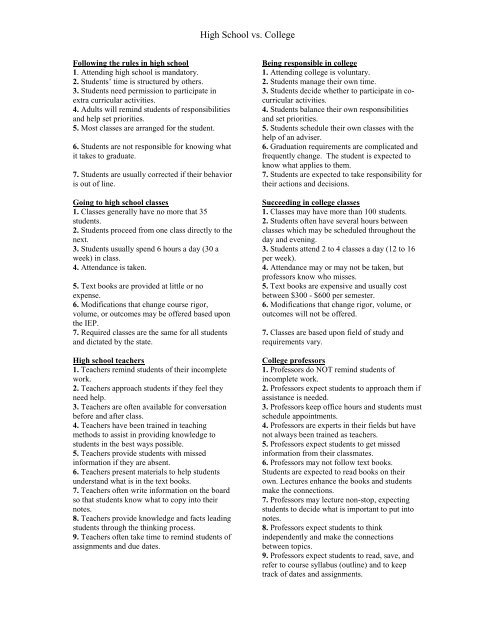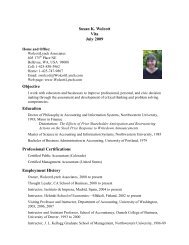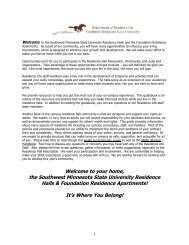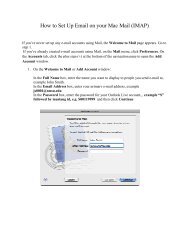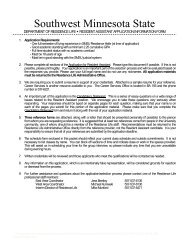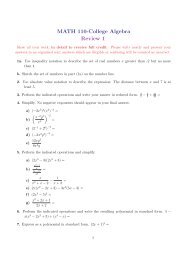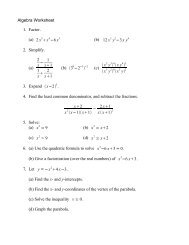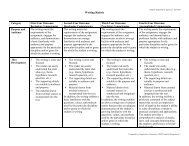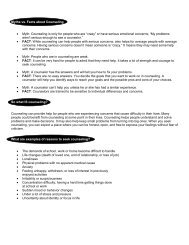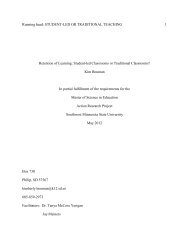High School vs College PDF
High School vs College PDF
High School vs College PDF
Create successful ePaper yourself
Turn your PDF publications into a flip-book with our unique Google optimized e-Paper software.
<strong>High</strong> <strong>School</strong> <strong>vs</strong>. <strong>College</strong><br />
Following the rules in high school<br />
1. Attending high school is mandatory.<br />
2. Students’ time is structured by others.<br />
3. Students need permission to participate in<br />
extra curricular activities.<br />
4. Adults will remind students of responsibilities<br />
and help set priorities.<br />
5. Most classes are arranged for the student.<br />
6. Students are not responsible for knowing what<br />
it takes to graduate.<br />
7. Students are usually corrected if their behavior<br />
is out of line.<br />
Going to high school classes<br />
1. Classes generally have no more that 35<br />
students.<br />
2. Students proceed from one class directly to the<br />
next.<br />
3. Students usually spend 6 hours a day (30 a<br />
week) in class.<br />
4. Attendance is taken.<br />
5. Text books are provided at little or no<br />
expense.<br />
6. Modifications that change course rigor,<br />
volume, or outcomes may be offered based upon<br />
the IEP.<br />
7. Required classes are the same for all students<br />
and dictated by the state.<br />
<strong>High</strong> school teachers<br />
1. Teachers remind students of their incomplete<br />
work.<br />
2. Teachers approach students if they feel they<br />
need help.<br />
3. Teachers are often available for conversation<br />
before and after class.<br />
4. Teachers have been trained in teaching<br />
methods to assist in providing knowledge to<br />
students in the best ways possible.<br />
5. Teachers provide students with missed<br />
information if they are absent.<br />
6. Teachers present materials to help students<br />
understand what is in the text books.<br />
7. Teachers often write information on the board<br />
so that students know what to copy into their<br />
notes.<br />
8. Teachers provide knowledge and facts leading<br />
students through the thinking process.<br />
9. Teachers often take time to remind students of<br />
assignments and due dates.<br />
Being responsible in college<br />
1. Attending college is voluntary.<br />
2. Students manage their own time.<br />
3. Students decide whether to participate in cocurricular<br />
activities.<br />
4. Students balance their own responsibilities<br />
and set priorities.<br />
5. Students schedule their own classes with the<br />
help of an adviser.<br />
6. Graduation requirements are complicated and<br />
frequently change. The student is expected to<br />
know what applies to them.<br />
7. Students are expected to take responsibility for<br />
their actions and decisions.<br />
Succeeding in college classes<br />
1. Classes may have more than 100 students.<br />
2. Students often have several hours between<br />
classes which may be scheduled throughout the<br />
day and evening.<br />
3. Students attend 2 to 4 classes a day (12 to 16<br />
per week).<br />
4. Attendance may or may not be taken, but<br />
professors know who misses.<br />
5. Text books are expensive and usually cost<br />
between $300 - $600 per semester.<br />
6. Modifications that change rigor, volume, or<br />
outcomes will not be offered.<br />
7. Classes are based upon field of study and<br />
requirements vary.<br />
<strong>College</strong> professors<br />
1. Professors do NOT remind students of<br />
incomplete work.<br />
2. Professors expect students to approach them if<br />
assistance is needed.<br />
3. Professors keep office hours and students must<br />
schedule appointments.<br />
4. Professors are experts in their fields but have<br />
not always been trained as teachers.<br />
5. Professors expect students to get missed<br />
information from their classmates.<br />
6. Professors may not follow text books.<br />
Students are expected to read books on their<br />
own. Lectures enhance the books and students<br />
make the connections.<br />
7. Professors may lecture non-stop, expecting<br />
students to decide what is important to put into<br />
notes.<br />
8. Professors expect students to think<br />
independently and make the connections<br />
between topics.<br />
9. Professors expect students to read, save, and<br />
refer to course syllabus (outline) and to keep<br />
track of dates and assignments.
<strong>High</strong> <strong>School</strong> <strong>vs</strong>. <strong>College</strong><br />
Special education in high school<br />
1. (IDEA) Individuals with Disabilities<br />
Education Act<br />
2. (FAPE) Free and Appropriate Public<br />
Education<br />
3. Services cover birth to age 21, or until a high<br />
school diploma is attained; based upon<br />
entitlement.<br />
4. Students receive special education and related<br />
services based upon identified needs.<br />
5. Behavior can be viewed as a manifestation of<br />
the disability.<br />
6. Accommodations and modifications are<br />
communicated to the teachers by the case<br />
manager.<br />
7. The environment is adjusted to the student.<br />
8. Services are delivered to the student<br />
9. The school informs the parents of the<br />
student’s progress.<br />
10. The case manager and/or parent act as the<br />
student’s advocate.<br />
11. <strong>School</strong>s are required to identify students with<br />
disabilities through free assessments.<br />
12. Services may include individually designed<br />
instruction, curriculum modifications and<br />
accommodations based upon the IEP.<br />
13. <strong>School</strong>s assist students with making<br />
connections with community resources.<br />
14. There are regular meetings to discuss the<br />
student’s progress.<br />
15. Assessment, physical therapy, and personal<br />
care are provided by the school while the student<br />
is in school.<br />
16. <strong>High</strong> school is mandatory and free.<br />
Studying in high school<br />
1. Students may study as little as 0-2 hours per<br />
week and this may be mostly to get ready for a<br />
test.<br />
2. Students often need to hear or read material<br />
only once to learn all they need to about the<br />
topic.<br />
3. Students read short assignments that are then<br />
discussed and often re-taught in class.<br />
4. Students are frequently told what they need to<br />
learn from assigned readings.<br />
Disability services in college<br />
1. 504 of the Rehabilitation Act of 1973<br />
2. Americans with Disabilities Act (ADA)<br />
3. Covers students with disabilities regardless of<br />
age; based upon nondiscrimination.<br />
4. Formal special education services are not<br />
available.<br />
5. Student must meet essential educational,<br />
behavioral, and other standards.<br />
6. Students must request accommodations and<br />
confer with professors.<br />
7. The student must adjust to the environment.<br />
8. Students must seek out services.<br />
9. The school cannot communicate with the<br />
parents without the student’s permission.<br />
10. The student is their own advocate.<br />
11. Students are responsible for revealing their<br />
disability and providing current documentation.<br />
12. Only reasonable accommodations are<br />
available.<br />
13. Students are responsible for making their<br />
own connections with community resources.<br />
14. Students are responsible to monitor their own<br />
progress.<br />
15. Students are responsible for personal service<br />
and care (PCA’s) as well as medical and related<br />
requirements.<br />
16. <strong>College</strong> is voluntary and very expensive.<br />
Studying in college<br />
1. Students need to study at least 2 to 3 hours for<br />
each hour of class.<br />
2. Students need to continually review class<br />
notes and text materials.<br />
3. Students may be assigned large amounts of<br />
reading and writing that may not be talked about<br />
in class.<br />
4. It is up to students to understand what must be<br />
learned from reading assignments
<strong>High</strong> <strong>School</strong> <strong>vs</strong>. <strong>College</strong><br />
Tests in high school<br />
1. Tests are frequent and usually cover only a<br />
small amount of material.<br />
2. Make up tests are often available.<br />
3. Teachers frequently rearrange test dates to<br />
avoid conflicts with school events.<br />
4. Teachers frequently conduct reviews prior to<br />
test days.<br />
5. Mastery is usually determined by the student’s<br />
ability to repeat what they have been told or<br />
read.<br />
<strong>High</strong> school grades<br />
1. Most assignments receive grades.<br />
2. Good homework grades may help to raise<br />
poor test schools.<br />
3. Extra credit options are usually available to<br />
raise a grade.<br />
4. Initial tests are often not counted, especially if<br />
they are low.<br />
Tests in college<br />
1. Tests are often infrequent and may cover large<br />
amounts of material going back to the beginning<br />
of the course.<br />
2. Make-up tests are almost never allowed.<br />
3. Professors generally schedule tests without<br />
regard to school events or other classes.<br />
4. Professors rarely offer review sessions. If they<br />
do, they are frequently scheduled at a different<br />
time and run by teacher assistants.<br />
5. Mastery is determined by the student’s ability<br />
to apply what they have been told or read to new<br />
situations.<br />
Grades in college<br />
1. Assigned work may or may not be graded.<br />
2. Tests and major papers provide the majority of<br />
the grade, but grade may be lowered if<br />
homework is not done.<br />
3. Extra credit options are not always available to<br />
raise a grade.<br />
4. First tests let you know what is expected of<br />
you and what types of tests the professor uses.


